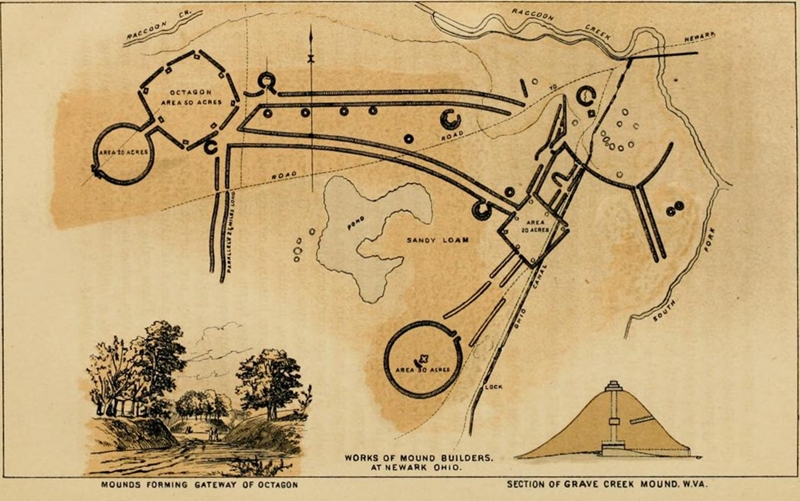
The Newark Earthworks in Ohio represent one of the most significant and awe-inspiring prehistoric monuments in the United States. Constructed by the Indigenous peoples of the Hopewell culture between 100 BCE and 500 CE, this architectural feat covers more than four square miles and includes an array of geometric figures, mounds, and enclosures. Through advanced and assertive examination, this article aims to offer a comprehensive exploration of the Newark Earthworks, shedding light on their construction, purpose, and enduring legacy within the broader tapestry of human history.
Historical Context & Construction
The earthworks were built by the Hopewell culture. A term archaeologists use to describe a network of trading peoples who shared a common way of life and a complex ceremonial system. The Hopewell were not a single tribe or society but a conglomerate of societies connected through trade, religious beliefs, and similar ways of life. They inhabited parts of what is now the Eastern and Central United States, leaving behind earthworks as enduring symbols of their cultural and spiritual beliefs.
The Art and Science of Earthwork Construction
Constructing the Newark Earthworks required sophisticated knowledge of mathematics, geometry, and astronomy, combined with tremendous labor efforts. The geometric precision of the earthworks, with shapes including circles, octagons, and squares, highlights the Hopewell’s advanced understanding of engineering and geometry. Researchers have suggested that the layout of these earthworks aligns with lunar and solar cycles, indicating their construction was not only for terrestrial purposes but also served as vast celestial observatories.
The Spiritual & Ceremonial Significance
The Newark Earthworks are believed to have served multiple functions, including as ceremonial sites, marketplaces, and spaces for social gathering. Central to their purpose was their role in the spiritual life of the Hopewell culture.
Alignments and Celestial Observatories
Evidence suggests that the Newark Earthworks played a crucial role in the Hopewell’s astronomical observations and ceremonies. The Octagon Earthwork, part of the Newark complex, aligns with the lunar standstill, an event that occurs every 18.6 years when the moon rises at its northernmost and southernmost points on the horizon. Such alignments indicate the earthworks were used to mark significant celestial events, underscoring the Hopewell’s deep connection with the cosmos.
Architectural Marvels of the Ancient World
The scale and complexity of the Newark Earthworks distinguish them as architectural marvels. Covering more than four square miles, the earthworks were among the largest constructions in the world at the time of their creation.
Geometric Figures and Mounds
The earthworks consist of several geometric figures interconnected by a network of earthen walls. The Great Circle Earthwork, with a diameter of about 1,200 feet, is nearly perfect in shape, showcasing an impressive level of precision. The Octagon Earthwork, connected to a circular enclosure by a short segment of parallel walls, serves as a testament to the Hopewell’s geometric sophistication and their ability to manipulate the landscape on a monumental scale.
Preservation & Legacy
Today, the Newark Earthworks are recognized as a National Historic Landmark and are part of the Hopewell Ceremonial Earthworks nomination for UNESCO World Heritage status. Preservation efforts focus on protecting these ancient structures from urban development and environmental degradation, ensuring their legacy endures for future generations to study and admire.
Address: 455 Hebron Rd. Heath, OH 43056
Challenges and Opportunities in Preservation
Preserving the Newark Earthworks presents unique challenges, including balancing public access with the need to protect sensitive archaeological sites. However, these efforts offer invaluable opportunities for education and research, providing insights into the complex societies that created these extraordinary monuments.
The Enduring Influence of the Newark Earthworks
The Newark Earthworks stand as a testament to the ingenuity and spiritual depth of the Hopewell culture. Their precision, scale, and alignment with celestial events highlight a sophisticated understanding of the world that challenges modern perceptions of ancient societies. As efforts to preserve these monumental earthworks continue, they remain a source of fascination and inspiration, symbolizing the rich cultural heritage of North America’s indigenous peoples.
Conclusion
In exploring the Newark Earthworks, we not only uncover the technical prowess and spiritual depth of the Hopewell culture but also gain a profound appreciation for the enduring legacy of America’s ancient builders. Their monumental achievements in earthwork construction continue to captivate scholars, visitors, and descendants of the indigenous peoples of the Americas
